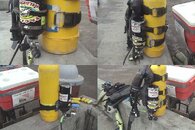You brought up another point that I wanted to ask a question about. Once I start diving with the pony, I imagine I'm going to have to drop some weight. But then what happens if I lose all my air from my main tank, it's now going to become positively buoyant. Then I start breathing from the pony and it starts to become buoyant, but because I dropped weight to compensate for the pony, won't I now be too buoyant as the pony gets lower on air?
How much weight, if any, should I drop?
Also, with the pony on a sling, do I need to compensate by adding more weight on the other side?
You should be weighted properly to account for the likely positive buoyancy your back gas cylinder will gain as the tank empties. That doesn't change because of the pony. I would not make any weighting changes if you are slinging a bottle.
Check out this
cylinder specification chart. You will see for most cylinders, especially for the AL19 that you have, the buoyancy swing from full to empty is pretty much negligible, at least with aluminum tanks, which is what you want for stage/deco/pony bottles. Also, consider that these figures are the buoyancy of the tank with valve. It doesn't take into account the weight of the reg and any of the hardware used to mount the bottle. So, in the end, those pieces of gear may offset the positive buoyancy of any empty pony anyway.
For such a small tank as an AL19, you won't need to shift any weight. I've had AL40s slung, and I don't change my weighting for that tank either. The main thing you need to do is get it set up and adjusted, and then get in the water and practice with it. Make sure you didn't trap the pony reg hose when you slung it and it can be deployed easily (this should be part of your pre-dive check every time anyways). Practice re-stowing the pony hose. Know which way to turn the valve to get it on in a hurry. Practice taking the bottle off and clipping it back on in case you did choose to pass it or had to remove it because it got hung up on something. Get used to doing a flow check on the bottle (pressurizing it and turning it off), and periodically check the gauge on it. If you see the HP gauge hose is slack or the gauge is reading zero, flow check it again. Sometimes your 2nd stage on a slung bottle will bump something and purge the gas. You want to keep it pressurized.
This
video shows how the bottle should look when slung and how the hose is stowed and deployed. It is assuming this is a deco bottle, so some of the steps don't really apply in your use of it. This
video shows bottle passing and a bunch of other stuff. Keep in mind this bottle pass is a planned event, not indicative of what it might look like if you were giving a bottle to someone who just had a catastrophic gas failure. Again, not all the stuff in these two videos will apply to you, but some more resources to watch and learn if you think it might help.





